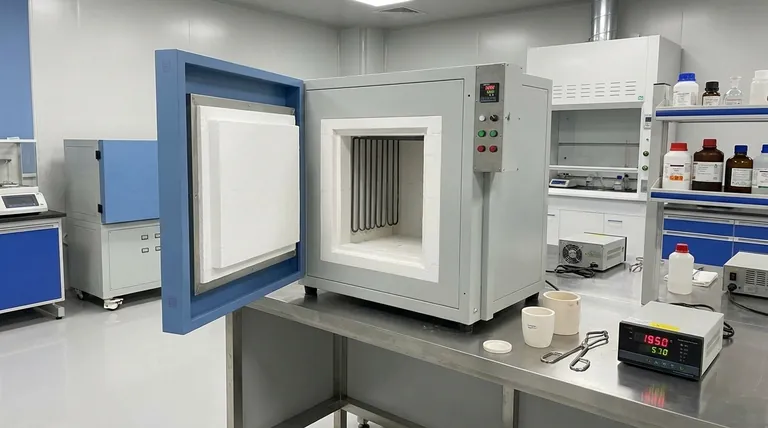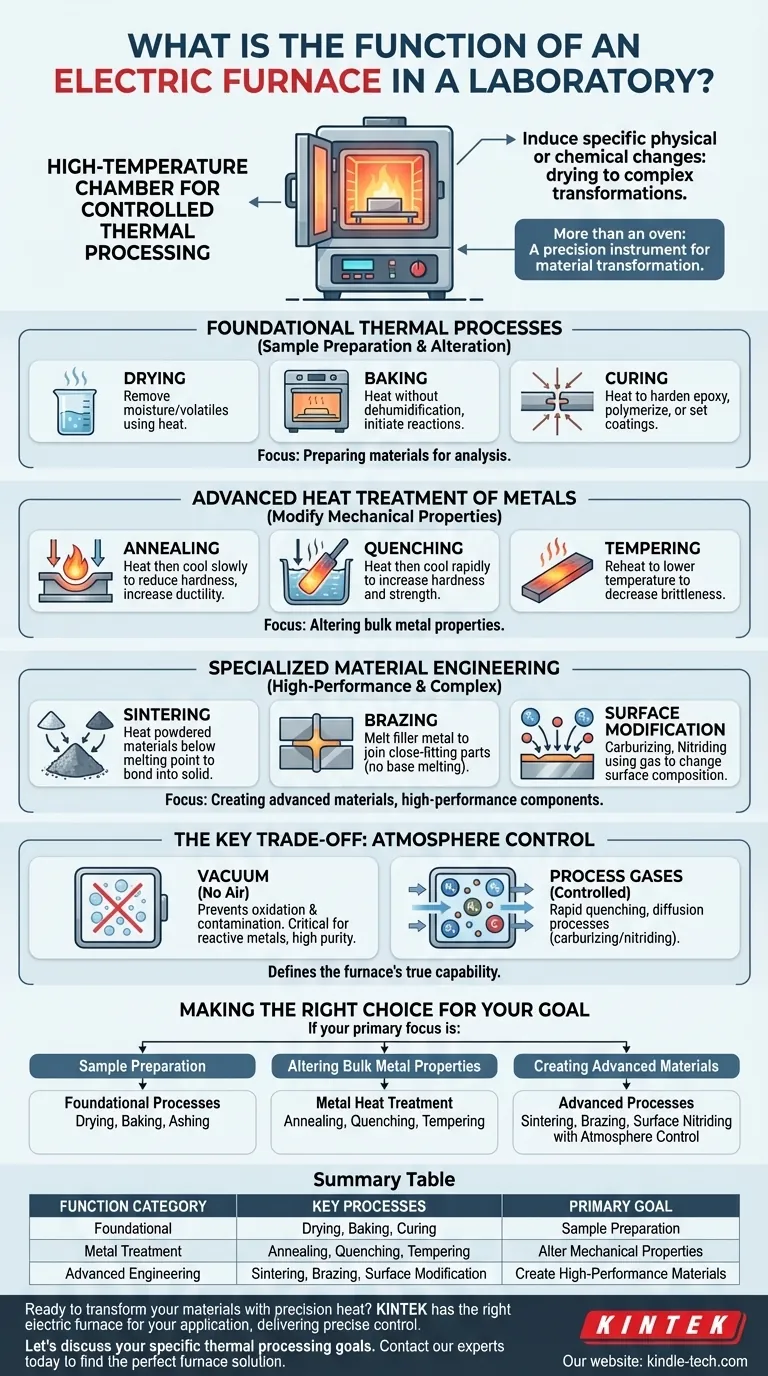At its core, a laboratory electric furnace is a high-temperature chamber designed for controlled thermal processing. Its primary function is to apply precise amounts of heat to a material to induce specific physical or chemical changes, ranging from simple drying to complex metallurgical transformations that fundamentally alter a material's properties.
A laboratory furnace is not merely an oven; it is a precision instrument for material transformation. Its purpose is to create a controlled high-temperature environment to dry, cure, or fundamentally re-engineer the characteristics of a substance or component.

Primary Applications: From Basic to Advanced
The functions of a laboratory electric furnace are best understood by categorizing them from foundational thermal processes to highly specialized material treatments.
Foundational Thermal Processes
The most basic applications involve using heat to prepare or alter samples.
- Drying: This is the process of using heat to remove moisture or other volatile liquids from a sample.
- Baking: In this context, baking involves heating a sample without the primary goal of dehumidification, often to initiate a simple chemical reaction or prepare it for a subsequent step.
- Curing: This function uses heat to cause a chemical or physical change, such as hardening an epoxy, polymerizing a compound, or setting a coating.
Advanced Heat Treatment of Metals
A key function of more sophisticated furnaces is the heat treatment of metals to modify their mechanical properties.
- Annealing: This involves heating a metal and then cooling it slowly to reduce hardness, increase ductility, and make it easier to work with.
- Quenching: The opposite of annealing, this process involves heating a metal and then cooling it rapidly (often in water, oil, or gas) to increase its hardness and strength.
- Tempering: Performed after quenching, tempering involves reheating the hardened metal to a lower temperature to decrease its brittleness while retaining most of its hardness.
Specialized Material Engineering
The most advanced furnaces enable complex processes used in high-performance fields like aerospace and materials science.
- Sintering: This is the process of heating powdered materials to a point just below their melting temperature, causing the particles to bond together and form a solid, dense object. It is fundamental to powder metallurgy.
- Brazing: A joining process where a filler metal is melted and flowed into a joint between two or more close-fitting parts, creating a strong bond without melting the base materials.
- Surface Modification: Processes like carburizing (adding carbon) or nitriding (adding nitrogen) use the furnace's heat and a specific gas atmosphere to change the chemical composition of a metal's surface, dramatically increasing its wear resistance and surface hardness.
Understanding the Key Trade-off: Atmosphere Control
The true capability of a laboratory furnace is often defined by its ability to control the environment inside the heating chamber. This is the main distinction between a simple oven and a powerful research tool.
The Role of a Vacuum
Many advanced processes are performed in a vacuum furnace. Removing the air from the chamber prevents oxidation and contamination at high temperatures. This is critical for processing reactive metals or creating high-purity materials where even trace amounts of oxygen would compromise performance.
The Impact of Process Gases
Conversely, some processes intentionally introduce specific gases. Furnaces capable of pressurized gas quenching can cool workpieces rapidly and uniformly. Processes like carburizing and nitriding rely on a controlled gas atmosphere to donate atoms that diffuse into the material's surface, fundamentally changing its properties.
Making the Right Choice for Your Goal
Selecting the right furnace or process depends entirely on your objective. The furnace is a versatile tool, but its functions are distinct and targeted.
- If your primary focus is sample preparation: You will likely use foundational processes like drying, baking, or ashing to prepare materials for analysis.
- If your primary focus is altering bulk metal properties: You need a furnace capable of precise temperature cycles for heat treatments like annealing, quenching, and tempering.
- If your primary focus is creating advanced materials or high-performance components: A furnace with vacuum or controlled atmosphere capabilities is essential for processes like sintering, brazing, or surface nitriding.
Ultimately, the function of a laboratory electric furnace is to give you deliberate control over the powerful force of heat to shape materials to your exact needs.
Summary Table:
| Function Category | Key Processes | Primary Goal |
|---|---|---|
| Foundational | Drying, Baking, Curing | Sample Preparation |
| Metal Treatment | Annealing, Quenching, Tempering | Alter Mechanical Properties |
| Advanced Engineering | Sintering, Brazing, Surface Modification | Create High-Performance Materials |
Ready to transform your materials with precision heat?
Whether your lab requires foundational sample preparation, advanced metal heat treatment, or specialized atmosphere-controlled processes, KINTEK has the right electric furnace for your application. Our equipment delivers the precise temperature control and environmental management you need to achieve consistent, reliable results.
Let's discuss your specific thermal processing goals. Contact our experts today to find the perfect furnace solution for your laboratory.
Visual Guide

Related Products
- High Temperature Muffle Oven Furnace for Laboratory Debinding and Pre Sintering
- 1700℃ Muffle Oven Furnace for Laboratory
- Laboratory Muffle Oven Furnace Bottom Lifting Muffle Furnace
- 1700℃ Laboratory Quartz Tube Furnace with Alumina Tube Tubular Furnace
- 1400℃ Muffle Oven Furnace for Laboratory
People Also Ask
- What is the use of high temperature muffle furnace? Achieve Pure, Contamination-Free Thermal Processing
- What are the safety precautions during brazing? Essential Guidelines for Hazard-Free Joining
- What is the annealing temperature of quartz? Achieve Optimal Thermal Stability for Your Components
- What is the purpose of a laboratory furnace? Achieve Precise High-Temperature Processing
- What is the difference between a furnace and an oven in a laboratory? Choose the Right Tool for Your Lab's Heat Needs



















